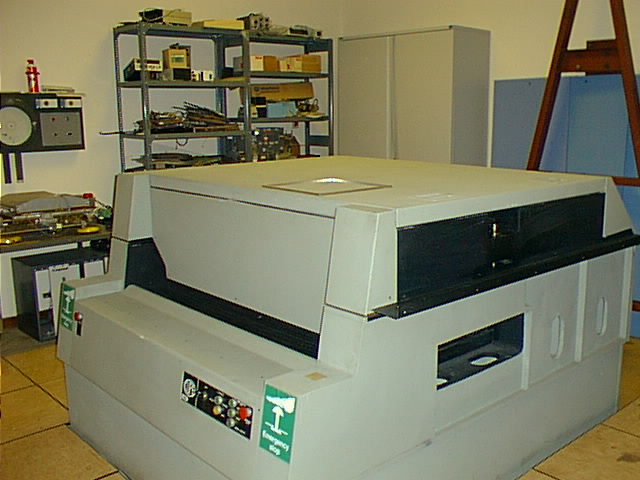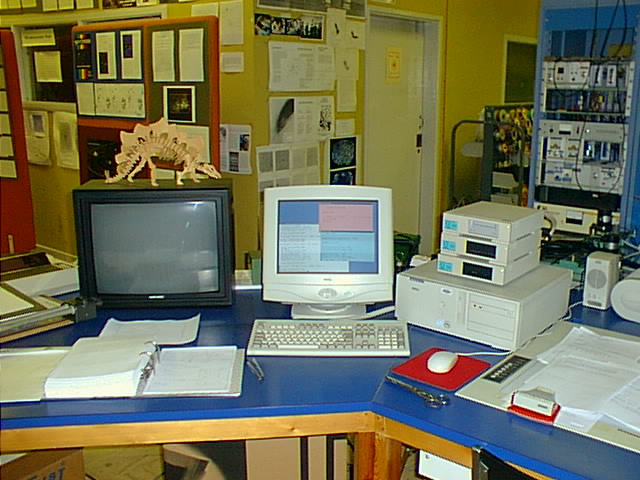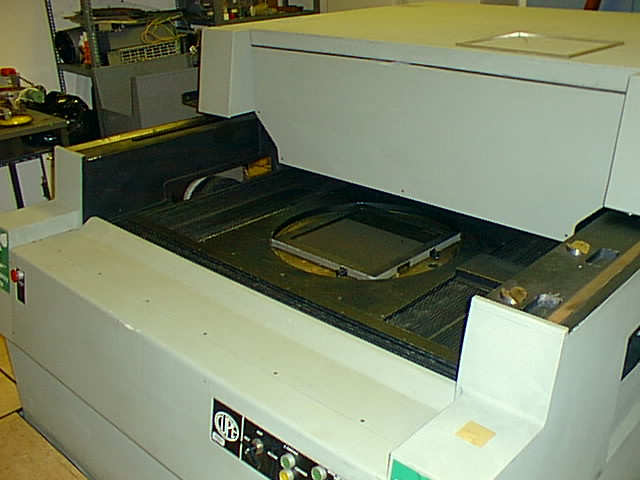Overview of the APM Facility
The Automatic Plate Measuring (APM) machine is a National Astronomy Facility
run by the Institute of Astronomy in Cambridge. The facility
typically processes a data stream of well over 10 Gbytes per day from
which the parameters of some 1 million images are extracted. The main source
of photographic material is the UKST, with secondary sources roughly equally
divided between Palomar Schmidt and Curtis Schmidt. Photographic plates from
4m class telescopes such as those at the AAT, KPNO, CFHT and CTIO observatories
are also regularly measured. In an average year the facility is available for
scanning roughly 90% of the time and typically over 1000 plates are measured.
The remaining time is divided between maintainence, repair and development
work.
A large part of the service provided by the facility consists of off-line data
processing and analysis to produce Astronomical results in a form readily
digestable by the average Astronomer. The scanner output has always been
routinely archived onto magnetic tapes -> Exabytes -> DATs. Consequently we
now have a library of measurements of several thousand plates which are
available for further use.
 The kernel of the APM system is a fast laser microdensitometer with a
dedicated hardware-based front end for essential routine signal
preprocessing. Control of the hardware and communication
with the CUPE microdensitometer is done via a purpose built PC EISA card,
while data aquisition uses a commercially available Spectral Instruments
PCI card capable of sustained transfer rates of up to 16 Mbyte/s - although
the ADC and signal processing hardware limit average data capture to
a more modest 1 Mbyte/s. A standard 200 Mhz Pentium-pro PC running
linux is used to both control the microdensitometer and perform
all the on-line data analysis.
The kernel of the APM system is a fast laser microdensitometer with a
dedicated hardware-based front end for essential routine signal
preprocessing. Control of the hardware and communication
with the CUPE microdensitometer is done via a purpose built PC EISA card,
while data aquisition uses a commercially available Spectral Instruments
PCI card capable of sustained transfer rates of up to 16 Mbyte/s - although
the ADC and signal processing hardware limit average data capture to
a more modest 1 Mbyte/s. A standard 200 Mhz Pentium-pro PC running
linux is used to both control the microdensitometer and perform
all the on-line data analysis.
The signal conditioning hardware, programmable via the PC interface
performs 16-bit analogue to digital conversion, look-up-table (LUT)
transformations from transmission to density (or intensity) and digitally
smears the spot if required. In addition it can also be used to compress the
pixel size, with output sample interval equal to N x N (up to 5) of the
original  scanner samples.
scanner samples.
The user interface is based on a simple Command Line Interface (CLI) program
written in C, as is most of the software used for controlling and analysing
the data from the scanner.
 The PC controls the complete scanning system, forms the control interface for
the user, and also carries out the image analysis. The high scanning
speed is achieved by sweeping the laser beam across the
plate in strips 2mm wide using an acousto-optic deflector. A massive x-y table
is used to move the plate relative to the beam and a scan is built up by moving
the table in the y direction with the x coordinate fixed. Subsequently the
table is moved 2mm in x and another y strip is measured. Each scan line within
the 2mm strip is digitised into 256 samples at
The PC controls the complete scanning system, forms the control interface for
the user, and also carries out the image analysis. The high scanning
speed is achieved by sweeping the laser beam across the
plate in strips 2mm wide using an acousto-optic deflector. A massive x-y table
is used to move the plate relative to the beam and a scan is built up by moving
the table in the y direction with the x coordinate fixed. Subsequently the
table is moved 2mm in x and another y strip is measured. Each scan line within
the 2mm strip is digitised into 256 samples at
 spacing.
spacing.
The
travel on each axis is 355mm which means that a complete Schmidt plate can be
measured at one sitting. The platten, upon which the assorted plate holders
plus plates sit, is rotatable by  . This enables us to accurately align the celestial coordinate system inherent on the
plate with the table x-y system.
. This enables us to accurately align the celestial coordinate system inherent on the
plate with the table x-y system.
During scanning an array of 9 Gbyte disks is used for intermediate storage of
pixel data. When a plate has been scanned and stored to disk,
background-following plus image detection and parameterisation is carried out.
The processing can be done in parallel whilst the next plate is being
measured.
Repeatibility measurements on isolated stars (including a
random walk between each measurement) indicate the rms table positional accuracy
to be better than  on each axis.
on each axis.
However, for more realistic tests
involving measuring the whole plate, taking it off, and then measuring it
again sometime later, the rms repeatibility is  for both axes.
The x-y table has absolute systematic errors of up to 3 microns on
both axes with a scale length of
for both axes.
The x-y table has absolute systematic errors of up to 3 microns on
both axes with a scale length of  cm.
This is a fixed systematic error inherent in the design of the x-y
table. It does not affect relative positional accuracy such as proper
motions or parallax measurement made with respect to background
galaxies since: either the plates are scanned in the same relative
position and the errors cancel out, or there are usually sufficient
background galaxies to adequately map out the effect.
cm.
This is a fixed systematic error inherent in the design of the x-y
table. It does not affect relative positional accuracy such as proper
motions or parallax measurement made with respect to background
galaxies since: either the plates are scanned in the same relative
position and the errors cancel out, or there are usually sufficient
background galaxies to adequately map out the effect.
 Re-imaging optics below the plate focus the transmitted laser light onto
a slit and through to the measuring photomultiplier,
the output of which is digitised at 16 bits and converted via a programmable
16 bit look-up table (LUT) into optical density.
The beam profile has a Gaussian core
Re-imaging optics below the plate focus the transmitted laser light onto
a slit and through to the measuring photomultiplier,
the output of which is digitised at 16 bits and converted via a programmable
16 bit look-up table (LUT) into optical density.
The beam profile has a Gaussian core  diameter surrounded by a
low intensity (-80 db) halo of scale size 1mm. By using a ``flying spot''
sampling rates of 200 KHz are readily attained. However, because of the halo
associated with the flying spot the usable optical density range is between
0 - 3.5 D. A servo system is used to maintain a constant laser beam
intensity and the photometric stability of the whole measuring process is
diameter surrounded by a
low intensity (-80 db) halo of scale size 1mm. By using a ``flying spot''
sampling rates of 200 KHz are readily attained. However, because of the halo
associated with the flying spot the usable optical density range is between
0 - 3.5 D. A servo system is used to maintain a constant laser beam
intensity and the photometric stability of the whole measuring process is
 .
.
The scanning and processing time for a complete UK or Palomar Schmidt plate
at 1/2 arcsec resolution is just over 4 hours.
Mike Irwin mike@ast.cam.ac.uk
Return to APM front page
 The kernel of the APM system is a fast laser microdensitometer with a
dedicated hardware-based front end for essential routine signal
preprocessing. Control of the hardware and communication
with the CUPE microdensitometer is done via a purpose built PC EISA card,
while data aquisition uses a commercially available Spectral Instruments
PCI card capable of sustained transfer rates of up to 16 Mbyte/s - although
the ADC and signal processing hardware limit average data capture to
a more modest 1 Mbyte/s. A standard 200 Mhz Pentium-pro PC running
linux is used to both control the microdensitometer and perform
all the on-line data analysis.
The kernel of the APM system is a fast laser microdensitometer with a
dedicated hardware-based front end for essential routine signal
preprocessing. Control of the hardware and communication
with the CUPE microdensitometer is done via a purpose built PC EISA card,
while data aquisition uses a commercially available Spectral Instruments
PCI card capable of sustained transfer rates of up to 16 Mbyte/s - although
the ADC and signal processing hardware limit average data capture to
a more modest 1 Mbyte/s. A standard 200 Mhz Pentium-pro PC running
linux is used to both control the microdensitometer and perform
all the on-line data analysis.
 scanner samples.
scanner samples.

 . This enables us to accurately align the celestial coordinate system inherent on the
plate with the table x-y system.
. This enables us to accurately align the celestial coordinate system inherent on the
plate with the table x-y system.
 for both axes.
The x-y table has absolute systematic errors of up to 3 microns on
both axes with a scale length of
for both axes.
The x-y table has absolute systematic errors of up to 3 microns on
both axes with a scale length of 
 diameter surrounded by a
low intensity (-80 db) halo of scale size 1mm. By using a ``flying spot''
sampling rates of 200 KHz are readily attained. However, because of the halo
associated with the flying spot the usable optical density range is between
0 - 3.5 D. A servo system is used to maintain a constant laser beam
intensity and the photometric stability of the whole measuring process is
diameter surrounded by a
low intensity (-80 db) halo of scale size 1mm. By using a ``flying spot''
sampling rates of 200 KHz are readily attained. However, because of the halo
associated with the flying spot the usable optical density range is between
0 - 3.5 D. A servo system is used to maintain a constant laser beam
intensity and the photometric stability of the whole measuring process is